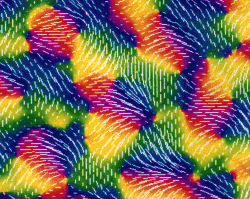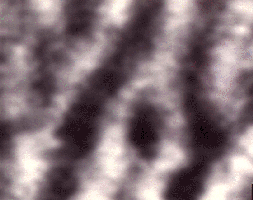

The nobel prize winning discoveries of Hubel and Weisel showed that
the primary visual cortex consists of cells responsive to simple and complex
features in the input. For example, most cells in the visual cortex respond
best to edges at some particular angle or the other (orientation preference)
or to inputs from one eye or the other (ocular dominance). Such properties
vary across the surface of the cortex gradually, and in complex patterns
called orientation columns and ocular dominance columns.


Orientation and ocular dominance columns in a patch of the monkey visual cortex visualized with modern imaging techniques (Blasdel and Salama 1992). In the first figure, colors varying from red to violet indicate orientation preference of cells varying from zero to 180 degrees. The overlaid white lines also show the orientation preference in each area. The second figure shows ocular dominance: color varying from white to black indicate eye preference varying from exclusive left to binocular to exclusive right.
Remarkably however, the patterns of orientation and ocular dominance are not fixed genetically, but develop from visual experience, mostly after birth. This was demonstrated in the cat visual cortex in a series of dramatic experiments. For example, a newborn kitten brought up in the dark for a few months stays blind for life though its eye and brain are apparently normal, solely because it didn't experience visual input in a critical period of its early development. A kitten with one eye closed for the first few months loses vision in that eye, but can see perfectly well with the open one. Similarly, if the kitten is brought up in an environment where it sees only horizontal lines, it has great difficulty in perceiving vertical contours and objects. Such experiments show that the visual cortex learns from experience, and self-organizes its structure to process visual input. This page is under construction